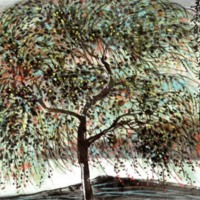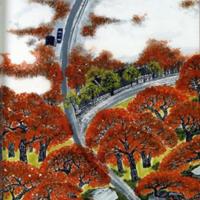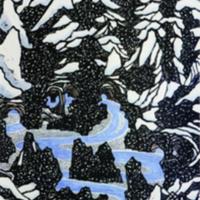Introduction
"In a landscape painting, a Chinese painter will never stand at a fixed point to look at the mountain because the view is limited. You cannot say there is only foreground, middle ground, and background, then all the mountains will look the same. Then, the painter is required to travel to the mountain, and then after he gets familiar with it, then he can choose his favorite spot and reorganize the space and the composition to show the features he enjoyed most into the painting. Consequently, the painting itself is a sort of portrait of the artist, in a way."
—Lo Ching, 2015
As art historian Eugene Y. Wang argues, traditionalism and modernism, East and West, radicalism and conservatism tend to converge or collide in Chinese contemporary art as a means to address the historical complexity underlying Chinese modernist aspiration. The Taiwanese poet-painter Lo Ch’ing adds to or disassembles the elements of Chinese traditional landscape paintings and transforms this tradition into a contemporary one. He claims to a return to the ancient masters of Chinese ink painting, but also contributes affective responses to the cyclical changes of the four seasons by attending to his own mental encounter with these landscapes.
Lo’s seasonal landscapes bear a juxtaposition of traditional brush strokes with newly created ones, conventional seasonal subjects with arbitrarily cropped views and colorful touch, and meteoric rocks floating within a traditional landscape setting. Most of his paintings develop imagery that attempts to adequately visualize the overall mood of each season, which will be further investigated in the following thematic sections: the vignettes, close-ups, and the metaphysical landscapes with rocks. One of his earlier poems Ode to the Southwest Wind exemplifies Lo’s feelings on the cyclical change of the seasons in a glance:
Ode to the Southwest Wind
In the spring the southwest wind has a fine hand
Especially fine in brushstrokes of air and light
The waves of the East China Sea offer testimony:
Putting time in motion for its ink, dipping into moonlight for water
The face of sun is its inkstone, flashes of lightning its brush
Unrolling long handscrolls of blue sky
Of limitless grasslands, and unrolling
The sea
After you have seen a lone bird fly in and out of the deep woods
Then you really understand calligraphy
The tip of its brush strikes –
It is filled with inky clouds and snowy splashes
In the depths dragons are startled, stones suddenly awakened
The power of the brush moves-
Autumn leaves pile up and scatter around the world, blown on
Running and fighting over the undulating ridges that fill the sky
A dot and a dash form a lonely valley
A hook and stroke set off mountain floods
Agitated it looks like sheets of rain across the ground
Relaxed it resembles the sweet growth of spring grasses
Leaning over like grain collapsing under full and heavy ears
Each intention starts out from the northern sea, thoughts gather together in the southwest reaches
And nonchalantly it writes the two rivers
Writes them into a long crazy cursive couplet full of feeling
It might either welcome the fog with open arms
Or bring together the mist and clouds
According to its inner desires
Sometimes the elbow flies, or the stylus runs
Releasing the clouds and setting off the rain
Occupying the west of west in the starry sky, it departs
But September
Offers this final evaluation:
It is like a taste of entangled misfortune
A brush with the arctic cold
After the leaves have fallen
And the waves flattened out
The depth of its calligraphic style
Is as the sea, deep
—Lo Ch’ing, November 1969



